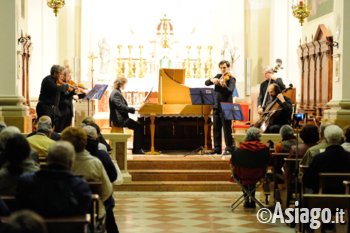Thursday 7/8/2014 at 21:00
Concerts

Parish Church-Roana-music by J.S.Bach, W.F.Bach, h. Casadesus, a. Vivaldi-Thursday, August 7
"Baroque Treasures" is the title of the concert that the Association & music of Roana offers to fans, on the evening of Thursday, August 7, at 21 in parish church in Roana.
Performing will be the ensemble "Musicalincanti" composed by Glauco Bailey, David Maheo and Matteo Marzaro violin, Andrea Maini (viola), Francesco Ferrarini cello, Franco Carter on double bass and Marco Vincenzi harpsichord. The Musicalincanti formation is a complex instrument born of some musicians specialising in ancient and Baroque music repertoire, active nationally and internationally and as usual, and other formations. Each component has a solo experience and contributor with important classical music ensemble (The Filarmonica della Scala, Wiener Philarmoniker, Orchestra di Padova e del Veneto, I sonatori della Gioiosa Marca, Cantilena Antiqua, Accademia Strumentale Italiana, Cappella Palatina, I Virtuosi Italiani) in addition to playing in various artistic events in Italy and Europe,. The ensemble "Musicalincanti" in 2009 was Record Special Award winner "Foundation" for civilization Farmsteads Veneta, within the international music competition "Gaetano Zinetti Chamber".
The program is specifically designed for putting out the various tools, which will alternate in being solo and then starring in songs.
You will start from the Concerto in F minor for harpsichord and strings F42 of w. f. Bach, son of Johann Sebastian.
The first musician who ventured to employ the harpsichord solo in it was Johann Sebastian Bach (the fifth Brandenburg Concerto) and later from his school who came the first real concerts for harpsichord and orchestra, many of whom signed by three sons Wilhem Friedemann, Johann Christian and Carl Philipp Emanuel. Wilhem Friedemann, beloved son of Johann Sebastian, began his career as an organist in 1733 and wrote five solo harpsichord concertos with string accompaniment. The composer took inspiration from his father's concerts, making in many cases the longer middle movement, something unusual in the Baroque period. The Concerto in F minor was composed in about 1767, the neoclassical era: not by chance, in fact, the first movement carries the designation "very cheerful", at that time a typical opening movement of Mozart's Symphonies. Follow a poetic Andante, the largest of the three movements, and a Prestissimo finale, very similar to a salon-like dance of rustic character.
Will follow, by h. Casadesus, the Concerto in c minor for viola and orchestra in the style of j. c. Bach.
Henri Casadesus founded Saint-Saëns with the "Société des Instruments Anciens". The company, which operated between 1901 and 1939, was a quintet of performers playing ancient instruments. Casadesus instrument was the viola d'amore. The Quintet is dedicated to the rediscovery of the works of musicians of the past is no longer performed for centuries. Recent studies have confirmed that several pieces attributed to famous musicians of the past (by j. c. Bach, c. p. e. Bach, Händel and far to Mozart) were actually Henri's compositions or his brother Marius, in the style of the composers to whom they were attributed. The Concerto in c minor for viola, in the style of j. c. Bach, has long become part of the repertoire for solo viola
.
Can't miss Antonio Vivaldi, which will execute the Concerto No. 8 in a minor RV 522 for two violins and orchestra, and Concerto in a major RV 158 for strings and harpsichord.
Antonio Vivaldi was violinist and composer of Baroque music among the largest known at all for the harmonious balance of parts and revered by j. s. Bach, his contemporary, who knew and transcribed the works to understand the style. Among the nearly three hundred concerts from Vivaldi on the violin, for two violins, about thirty, extended throughout the composer's creative, constitute a kind of special concert. It is with these poems, in fact, that is the passage from the concerto grosso (inaugurated by another famous Italian musician, Arcangelo Corelli) in concert, in this case, "with two violins obliged" i.e. a double concert, a sort of extension of the concept of solo concert.
The Concerto in a major for strings and harpsichord RV 158, creating less note of Vivaldi, belongs to the type of symphonic concert, which is written for four parts of strings, and continuo without solo instruments. For this reason, presents a tougher character that might suggest to a concert by the Church, which is evidenced by the contrapuntal character of the two "Allegro", as opposed to the rhythms of the median time bulleted "Andante very"
By j. s. Bach, finally, the Concerto in a minor, BWV 1041 for violin, strings and basso continuo.
Bach composed probably about ten concertos for violin and orchestra, but we have only three to which must be added a snippet 50 characters of a Concerto in D major. In these compositions certainly Bach takes into account the shape in three movements created in manuscript compositions, although in his concertos for violin and orchestra writing is more solid and compact. The Concerto in a minor for violin and strings belong to the fruitful period of Köthen and was written for small orchestra of Prince Leopold. The violin serves not as a solo instrument, in the modern sense, but as violin concertante, rivaleggiante in skill with others.
Violins: Glauco Bailey, Matteo Marzaro, David Maheo
Viola: Andrea Maini
Cello: Francesco Ferrarini
Double Bass: Franco Catalini
Harpsichord: Marco Vincenzi
As always, admission is free.
All rights reserved.